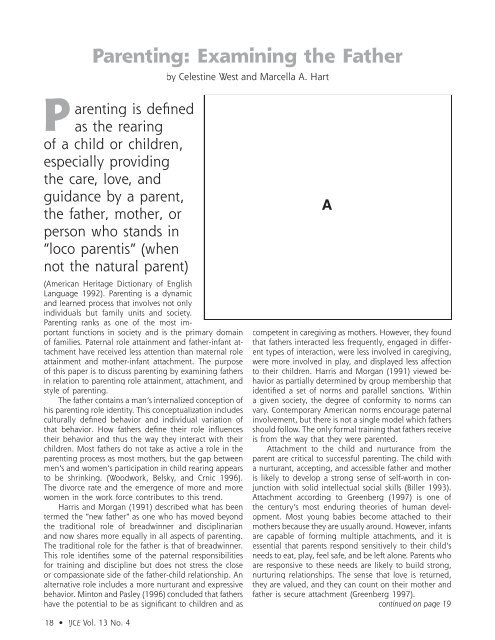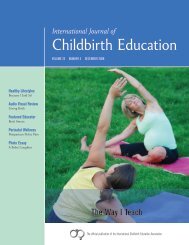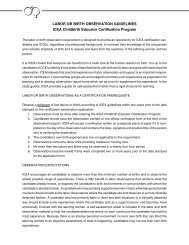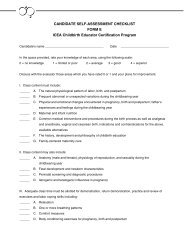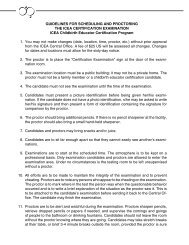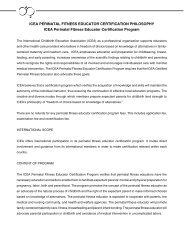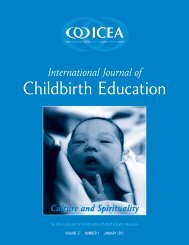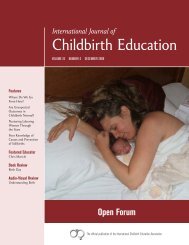JOURNAL - International Childbirth Education Association
JOURNAL - International Childbirth Education Association
JOURNAL - International Childbirth Education Association
Create successful ePaper yourself
Turn your PDF publications into a flip-book with our unique Google optimized e-Paper software.
Parenting: Examining the Father<br />
by Celestine West and Marcella A. Hart<br />
P<br />
(American Heritage Dictionary of English<br />
Language 1992). Parenting is a dynamic<br />
and learned process that involves not only<br />
individuals but family units and society.<br />
Parenting ranks as one of the most im-<br />
portant functions in society and is the primary domain<br />
of families. Paternal role attainment and father-infant attachment<br />
have received less attention than maternal role<br />
attainment and mother-infant attachment. The purpose<br />
of this paper is to discuss parenting by examining fathers<br />
in relation to parenting role attainment, attachment, and<br />
style of parenting.<br />
The father contains a man’s internalized conception of<br />
his parenting role identity. This conceptualization includes<br />
culturally defined behavior and individual variation of<br />
that behavior. How fathers define their role influences<br />
their behavior and thus the way they interact with their<br />
children. Most fathers do not take as active a role in the<br />
parenting process as most mothers, but the gap between<br />
men’s and women’s participation in child rearing appears<br />
to be shrinking. (Woodwork, Belsky, and Crnic 1996).<br />
The divorce rate and the emergence of more and more<br />
women in the work force contributes to this trend.<br />
Harris and Morgan (1991) described what has been<br />
termed the “new father” as one who has moved beyond<br />
the traditional role of breadwinner and disciplinarian<br />
and now shares more equally in all aspects of parenting.<br />
The traditional role for the father is that of breadwinner.<br />
This role identifies some of the paternal responsibilities<br />
for training and discipline but does not stress the close<br />
or compassionate side of the father-child relationship. An<br />
alternative role includes a more nurturant and expressive<br />
behavior. Minton and Pasley (1996) concluded that fathers<br />
have the potential to be as significant to children and as<br />
arenting is defined<br />
as the rearing<br />
of a child or children,<br />
especially providing<br />
the care, love, and<br />
guidance by a parent,<br />
the father, mother, or<br />
person who stands in<br />
“loco parentis” (when<br />
not the natural parent)<br />
A<br />
competent in caregiving as mothers. However, they found<br />
that fathers interacted less frequently, engaged in different<br />
types of interaction, were less involved in caregiving,<br />
were more involved in play, and displayed less affection<br />
to their children. Harris and Morgan (1991) viewed behavior<br />
as partially determined by group membership that<br />
identified a set of norms and parallel sanctions. Within<br />
a given society, the degree of conformity to norms can<br />
vary. Contemporary American norms encourage paternal<br />
involvement, but there is not a single model which fathers<br />
should follow. The only formal training that fathers receive<br />
is from the way that they were parented.<br />
Attachment to the child and nurturance from the<br />
parent are critical to successful parenting. The child with<br />
a nurturant, accepting, and accessible father and mother<br />
is likely to develop a strong sense of self-worth in conjunction<br />
with solid intellectual social skills (Biller 1993).<br />
Attachment according to Greenberg (1997) is one of<br />
the century’s most enduring theories of human development.<br />
Most young babies become attached to their<br />
mothers because they are usually around. However, infants<br />
are capable of forming multiple attachments, and it is<br />
essential that parents respond sensitively to their child’s<br />
needs to eat, play, feel safe, and be left alone. Parents who<br />
are responsive to these needs are likely to build strong,<br />
nurturing relationships. The sense that love is returned,<br />
they are valued, and they can count on their mother and<br />
father is secure attachment (Greenberg 1997).<br />
continued on page 19<br />
18 • IJCE Vol. 13 No. 4


